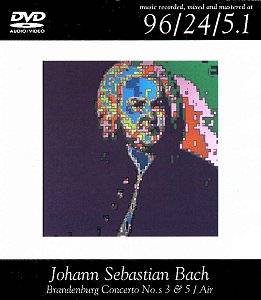My
first reaction on reading the label of this recording was to be
a little apprehensive of a full symphony orchestra playing these
works, since a large string orchestra playing particularly the
Brandenburg #3 can sound like turbulent if agreeable sonic
mush. But, not to worry, only the leading players are involved
in the Brandenburgs, and they play as well as anyone has ever
played these works, with a nice awareness of original performance
practice but with rich tone and a lyric sense of phrase. Tempi
are about the current norm, somewhat brisk by older standards.
The Ďslow movement problemí of #3 is solved by having the
harpsichordist improvise some runs and arpeggios, coming in for
a landing on the famous cadential chords, and then itís off to
the races again. The harpsichordist, pianist Nicolae Licaret,
plays the demanding part in #5 as well as Iíve ever heard
it played. This takes courage because before high resolution recording
you couldnít hear all the mistakes, and they all made them, including
the great Veyron-LaCroix. Consider the extreme difficulty of this
part: the harpsichordist, playing both the continuo and
concertato keyboard parts never stops playing, not for
one second, during the entire work. He probably plays ten times
as many notes as in the Beethoven Emperor Concerto.
I
once tried to start an argument by stating flatly that the Brandenburg
Concerto #5 is the greatest single piece of music ever written
(at least in the 15 to 40 minutes instrumental class), but failed
because after a little discussion everybody in the room came to
agree with me.
To
see how this disk would play in a DVD (video) player I put it
in my new Sony DVD/SACD player which contains a 96kHz D/A audio
chip. There is also a firm notice in the booklet that it does
not (sniff!) play DVD-Audio disks. The AIX logo
(unfortunately not a silent one!) appeared on the screen and then
the audio set-up menu, and when I didnít click anything, almost
at once the 96kHz PCM stereo track began to play. Even in two
channel stereo there was a magical clarity, every note of the
harpsichord audible but not overly prominent, and the clear separation
of the ripieno from the concertino. On the screen
is a playlist of tracks including entries to other menus. Upon
returning to the audio set-up menu, I selected DTS surround sound
and there I was, seated at the harpsichord, with the ripieno
to the left (front) and the concertino to the right (rear).
Every note of every instrument was brilliantly clear. Iíve never
heard this music like this before, with the interplay between
the soloists and the string orchestra so clear and distinct. I
found myself listening to the second solo viola in #3,
a part Iíd never noticed before. Certainly I had never appreciated
the complexity of this work which before had always been little
more than an agreeable bouncy muddle of string sound.
As
if this wasnít good enough, on a true DVD-Audio player the same
selection of tracks is available in significantly clearer sound.
There
will probably be those people for whom music is exclusively a
Ďspectator sportí who will condemn this surround sound as a useless
gimmick. They will insist that we always hear music coming from
the stage and thatís how it should always be recorded. But thatís
not true. The composer, the conductor, and the musicians hear
the music close-up, all around them. Those of us who always wanted
to be performing musicians want to hear music that way, and itís
a perfectly valid intellectual and æsthetic experience.
And on this disk you have your choice.
For
the aria from Suite #3, we do hear an apparently larger string
ensemble with harpsichord up front on the lute register joining
the pizzicato low strings in the accompaniment to produce a beautiful
sound. As usual, the work is played too slow, but there is no
sentimentalising, just generous breathing phrases and a rich cantilena.
Paul
Shoemaker
